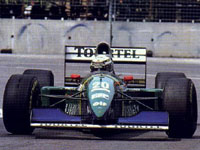Swiss clock running slow
Author
- Mattijs Diepraam
Date
- 8W April 1999 issue
Related articles
- Philippe Adams - Bus stop tourist, by Mattijs Diepraam
- Yannick Dalmas - Fallen legionnaire, by Mattijs Diepraam
Who?Jean-Denis Délétraz What?Larrousse-Ford LH94 Where?Adelaide When?1994 Australian GP |
 |
Why?
Meet the man responsible for the introduction of the 107% performance rule.
In his GP career of three events, Jean-Denis Délétraz did nothing but embarrass himself, while making a fool of his Larrousse team for needing to revert to a pay driver that had no race wins to show for in the lower categories and ostensibly out of his depth at this level. Today, it seems, you can visit your local FIA supermarket, buy a huge lettuce and get a superlicense as an added bonus...
Actually, we're not being totally fair.
With the development of advanced driver aids allowing the top teams to take enormous strides ahead, the teams hamstrung by tiny budgets severely lagged behind in the mid-nineties. Looking at the qualifying deficits of 1993 and 1994 sometimes the last two or even the last three rows of the grid would not have qualified under the 107% rule - and these included cars from Tyrrell, Larrousse, Minardi, and even Jordan. Ironically, with much of the new high-tech development banned after Senna's fatal accident, the smaller teams found it harder to adjust to the sudden change in racing environment, new teams like Simtek and Pacific suffering most. The 1995 season saw the largest qualifying gaps in modern F1 history, with only the 18 or 20 or so fastest drivers complying with the later introduced 107% rule. Struggling to keep up with the seering pace at the front, even regular midfield runners such as Lotus, Arrows or Larrousse were forced to allow in rent-a-drivers to pay for development bills. Jean-Denis Délétraz was just one of them, with the likes of Taki Inoue, Giovanni Lavaggi and Philippe Adams also popping into mind.
Remarkably, Délétraz wasn't as bad as his dismal F1 record wants us to believe. Just as Ricardo Rosset - another man dismissed as a pay driver - Jean-Denis was a good racer in F3000, having scored podium finishes to prove it. But somehow in F1 both Rosset and Délétraz seemed overwhelmed. Jean-Denis' qualifying pace in his debut event at Adelaide was, well, adequate, but in the race JDD featured as a mobile chicane, his cornering speeds tumbling to absurd lows. Was he trying to get in front of the leaders as much as possible to claim more air time for his ailing team's sponsors?
When he returned to the Grand Prix tracks in 1995 to give Pacific a much-needed financial break, Délétraz continued the theme into qualifying, forcing us to cast aside that theory. At Estoril, he set shockingly slow lap times, 15 seconds down on Coulthard and trailing Roberto Moreno - his partner on the last row of the grid - by a massive 7 seconds, and doing only marginally better in the European GP, with just 11 seconds in it. This was a gap that even team mate and Pacific co-owner Bertrand Gachot had become used to during the season.
But those 15 seconds must have done it.
For Roberto Moreno, having driven his Forti balls-out to come within 8 seconds of a Williams-Renault, Délétraz lining up immediately next to him must have felt like an insult. For 1996, FIA rightfully introduced the then much-criticised performance rule. At the time, it will have seemed harsh, but while the 12-team maximum rule for 2000 was a ludicrous one, preventing new teams to enter F1 on their own terms, the 107% rule has proved its sense, working like a charm in 1997 by killing off the embarrassing Lola effort with a single stroke.
